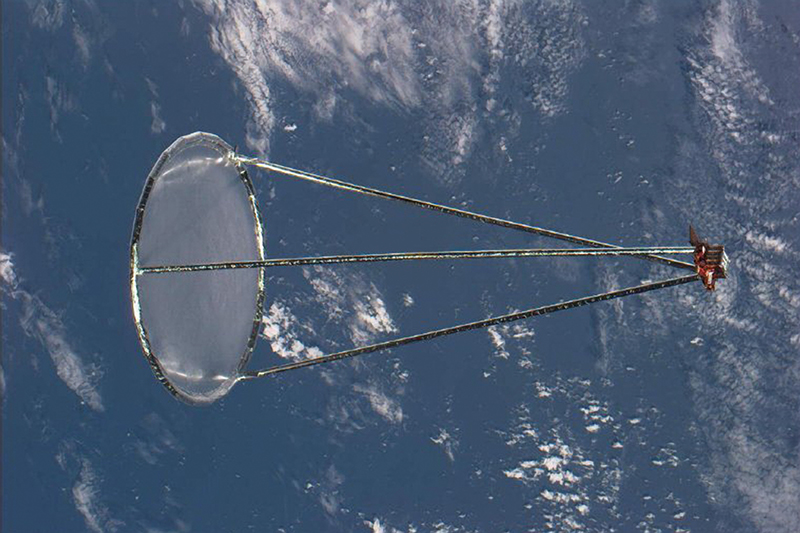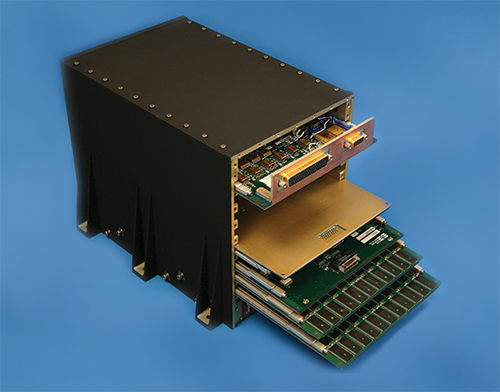
Solid-State Recorders Enhance Scientific Data Collection
Originating Technology/NASA Contribution
On May 20, 1996, astronauts aboard the Space Shuttle Endeavor watched as a unique structure unfolded in space like a complex trick of origami. From the free-flying Spartan satellite the STS-77 crew had released from the shuttle’s cargo hold, a massive circular antenna inflated into shape. About the size of a tennis court, the Inflatable Antenna Experiment (IAE) was the first space structure of its kind, laying the foundation for future work on inflatable satellites, telescopes, and even astronaut dwellings.
After the IAE’s deployment, the structure was jettisoned and the Spartan satellite was recaptured by the shuttle. Key to the experiment’s success was a new device onboard the satellite that recorded and stored the critical test data.
Partnership
Prior to the IAE, most NASA satellites and missions logged data using magnetic tape recorders. In terms of data gathering and storage, these missions were limited to how much these devices could record and how fast. The recorders’ mechanical systems also made them vulnerable to failure; backup recorders took up valuable onboard real estate and added to cost and launch weight.
In 1983, National Reconnaissance Office pioneer Ray Anderson and son Scott founded SEAKR Engineering Inc., based in Centennial, Colorado. Ray Anderson had recognized that tape recorders represented a life-limiting spacecraft component, and SEAKR set about developing a replacement device that would lower cost while increasing reliability and capacity. The company turned to solid-state technology for a solution.
Solid-state, or flash memory, devices are crafted entirely from solid materials in which the only moving parts are electrons. A solid-state recorder (SSR) stores information in binary code (0s and 1s) in tiny transistors; transistors conducting current have a value of 1, while those that are not have a value of 0. Since there are no moving parts that could fail, and the information in the recorder can only be altered by voltage changes in the transistors, solid-state technology offers a more reliable, durable, and compact method of data storage. (Think of replacing a cassette player with an iPod nano.)
SEAKR first demonstrated its space-ready, SSR technology on a U.S. Department of Defense satellite before launching a device on the NASA-funded Orbital Sciences SeaStar satellite (now known as OrbView-2), which carried the Sea-viewing Wide Field-of-View Sensor (SeaWiFS) for imaging of the Earth’s oceans. Under Small Business Innovation Research (SBIR) contracts with Goddard Space Flight Center, the company then built the SSR that replaced the original tape recorder on the Spartan satellite and gathered the test data for the IAE mission. SEAKR’s NASA work helped the company advance its SSR technology.
“Demonstrating that you have a sound design that functions in space is a difficult hurdle to get over,” says Scott Anderson, SEAKR’s president. “Once we got over that hurdle, the fact that we were a small company with extremely low cost structures put us in a position to win opportunities as programs and customers switched from tape recorders to solid state.”
SEAKR’s SSRs opened up new capabilities for space missions that were previously hampered by tape recorder limitations.
“Suddenly, that bottleneck disappeared. Multiple, different instruments could record at the same time. They could run at considerably higher data rates,” says Anderson. “The capacities of these solid-state systems considerably outperformed the tape recorders. They became mission-enabling technologies.”
Product Outcome
Today, SEAKR is the world leader in solid-state recorder technology for spacecraft. The company has delivered more than 100 systems, more than 85 of which have launched onboard NASA, military, and commercial spacecraft, and none of which have experienced on-orbit failure. The company has also built upon its expertise with solid-state electronics to branch out into other critical flight technologies.
“If you think about what’s in a solid-state recorder—a microprocessor, a lot of memory, software, packaging technologies—that’s all the same technologies that’s in a flight computer,” Anderson says. “Building high performance computers for spacecraft is now our largest growing market segment.” The company also offers bulk memory module products it says arose from technology developed for NASA programs like the Small Spacecraft Technology Initiative, the Mars Global Surveyor, and Mars Polar Lander.
SEAKR hardware has flown on many NASA missions, from satellites and planetary probes to the space shuttles and the Spitzer and Kepler space telescopes. The company’s SSRs have recorded data for the Mars Global Surveyor and Mars Reconnaissance Orbiter, and SEAKR developed the High Rate Communication Outage Recorder (HCOR) for the International Space Station. The HCOR allows separate nodes within the station to route their science and communication data to a single, large memory buffer.
Outside of NASA, SEAKR has used its solid-state technology to build more than 1,100 memory boards for the U.S. Air Force C-17 Globemaster cargo aircraft. SEAKR SSRs are also part of the GeoEye-1 and WorldView-1 imaging satellites, which provide much of the high-resolution imagery for online mapping services.
“Whenever you see a picture on Google Earth, there’s a good probability that the image came through one of our recorders,” says Anderson.
SEAKR’s technological accomplishments continue to push the limits of solid-state space electronics. Through the Internet Routing in Space project, the company collaborated with Cisco Systems and the Department of Defense and built a space-hardened Internet router that allows Web access and communications to occur directly through satellites rather than double-hopping to and from stations on Earth, a capability that may one day allow quick and highly reliable communications for soldiers in the field.
SEAKR is also working on another SBIR partnership with Goddard to build a high-performance flash-based memory module based on the VPX electronics standard, which allows for greater power and ruggedness. The results, Anderson says, will continue to advance the technology that demonstrated its usefulness so readily on the Spartan satellite nearly 15 years ago.
“This is going to be a great collaboration,” says Anderson. “NASA is helping us fund a technology that is going to push the performance of these systems in the future.”
iPod nano® is a registered trademark of Apple Inc.
Google Earth™ is a trademark of Google Inc.

SEAKR’s SSRs have become mission-enabling technologies, playing a vital role in many NASA missions and onboard multiple commercial satellites.

The Inflatable Antenna Experiment, seen here fully deployed from its Spartan satellite, logged its data on an SBIR-derived solid-state recorder (SSR) developed by SEAKR Engineering Inc.













